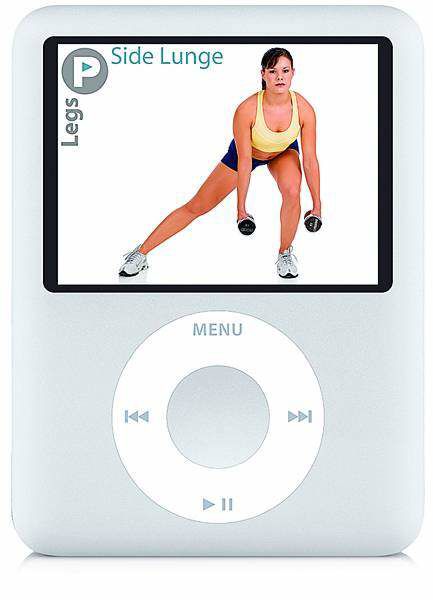Downloadable fitness
Published 5:00 am Thursday, June 19, 2008

- New portable video technology has created a market for exercise videos that can be downloaded from the Web and brought to the gym.
Credit Jane Fonda with popularizing the exercise video. The original Jane Fonda’s Workout video released in 1982 sold 17 million copies, still a record for an exercise tape.
But many purchasers soon learned that any exercise videotape has serious drawbacks. It’s always the same workout, so over time, fitness gains stagnate. And while it’s great at home, it’s less helpful if you need guidance at the gym or on the road, where lugging a TV and VCR would be a workout in itself. It’s why exercise videotapes and DVDs have now become a staple of yard sales.
Trending
Three decades post-Fonda, however, exercise videos are making a comeback. The ubiquity of personal technology, such as iPods, cell phones and other handheld gadgets, is offering fitness enthusiasts a new platform for receiving fitness instruction. The ease and low cost of downloading new or customized workouts has solved many of the drawbacks of videotapes or DVDs.
Increasingly, exercising individuals are using their iPods and MP3 players not just to listen to music but as virtual personal trainers, providing coaching, instruction and motivation they can slip into their pockets.
Audio first
As MP3 players replace Walkmans and CD players, people no longer have to trek down to a store to purchase new training regimens. They can download audio fitness instruction from any computer with Internet access.
Sites like iTrain and Podfitness.com emerged to provide a mix of motivating music with voice commands guiding you through a workout. Many make use of celebrity voices, like former Partridge Family child star Danny Bonaduce or Olympic swimmer Natalie Coughlin. You can download workouts from www.itrainer.com.au, based in Australia, and be directed through your workout by a trainer with an Aussie accent.
At most sites, you pay a monthly fee, usually $20 to $30, and download a number of workouts for the month. Some offer a customized program, asking you to provide some details about your fitness level and your goals. They then come up with a series of sessions that you can download to your MP3 player.
Trending
Most provide appropriately tempoed music, while others search through the collection of music on your computer to find songs that you like that match the intensity of the exercise.
But while audio-only downloads are great for runners, spinners or swimmers, it’s a lot tougher to grasp a yoga movement or the correct form of a strength training exercise through sound alone. And when Apple released its video iPod three years ago, it greatly expanded the types of workouts that were feasible for download.
Pictures are better
Ahead of the curve, Diane Murray, co-owner of the Pilates Center of Bend, created the first-ever Pilates video podcasts in 2006.
“By doing those podcasts, I was able to reach people all over the world that did not have access to Pilates or any exercise class for that matter,” Murray said. “Almost from day one, I got e-mails from people all very appreciative that I did that.”
Murray’s podcasts were small bites, teaching a single movement. She’s resisted putting a full workout online despite many devotees clamoring for it. It was more a marketing effort to bring attention to her studio. The studio’s Web site comes up much higher on Internet searches because of the podcasts, she says.
But the downside of using a downloaded video is that there is nobody to ensure your form is correct.
“It’s a lot harder to keep good form when you don’t have an instructor paying attention, especially when you’re a beginner,” she said. “Even for people doing regular videos, they’re not able to keep up.”
Her 12 podcasts each demonstrate one basic movement, so they’re better suited for beginners or people who might need a reminder on how to perform them.
“As they are learning, they can use those podcasts at home, because many people can’t afford to come three or four times a week,” she said. “Or when my clients are on vacation, they may not be motivated to do it themselves, but if they have me doing their exercises on their iPods, that’s a little more motivating.”
Still, she had to be careful to fully explain the exercises to ensure viewers learn it correctly and don’t hurt themselves.
Kimberly Fowler, owner of YAS Yoga and Spinning Studio in Venice, Calif., started with audio downloads herself and imagined trying to teach a blind person when recording them. Now she’s doing mainly video downloads.
“I think it’s nice to be able to see what the person is talking about,” she said.
Fowler initially sold her Yoga for Athletes DVD through iAmplify .com, charging $20 to download the entire 53-minute workout.
“A lot of my students buy it because they take me on the road with them,” she said. “You don’t bring your DVD (player) with you when you’re traveling. You bring your iPod.”
Fowler, who lived in Bend in the early ’90s, said four or five years ago, when personal technology had less memory and Internet connections were slower, audio was the only viable option. Better technology is driving more people toward video workouts.
“The reason it’s getting popular is because everybody’s got DSL. They’ve got cable. They’ve got fast Internet. It takes no time to download,” she said. “I think that is helping the trend.”
Video libraries
As a result, download sites offering workout videos are sprouting up all over the Internet. Fowler’s latest video, Yoga for Runners, is now available on Apple’s iTunes online store, which still dominates the download market.
Other sites have created a library of workout videos available for download. PumpOne.com, one of the largest exercise download sites, started offering video workouts in October.
Craig Schlossberg, president of PumpOne, says in some gyms in the country as many as half of gym-goers are now using portable video to direct their workouts.
“If someone tells you to do a twisting biceps curl, if someone is telling you, it’s a lot different than seeing it,” he said. “The moment these devices went visual, you started to be able to put a lot of different concepts on there.”
PumpOne has downloads for yoga, Pilates, cross-training, strength training, stretching or heart healthy workouts, and offers customized workouts through a network of 5,000 personal trainers nationwide.
And in July, PumpOne will launch a new product targeted at Apple iPhone users. Owners will be able to make a phone call and download one of 80 workouts to their phone to use one time, on the spot.
Schlossberg said people often make the same mistake with downloadable workouts as they did with the old videos and DVDs. Purchasing the video won’t help you lose weight or get fit; you actually have to use it.
He also said users shouldn’t just download one program and stick to it.
“When you go back to the gym with a personal trainer, he’s doing yet another new workout,” Schlossberg said. “With the portable personal trainer, if you didn’t continue and get a new version, what are you doing? You just learned one new workout and in six months you’re back to where you started.”
With the potential for these exercise videos to supplant real personal trainers, gyms, fitness organizations, even physical therapy outfits are now creating such videos for their clients.
The National Strength and Conditioning Association, for example, now has a video library demonstrating how to perform various weight-lifting techniques correctly.
Kevin Collins, West Coast regional director for Dartfish, which developed the video software used by the strength training group, said other fitness organizations may soon follow suit, augmenting their live fitness training with videos. That could bridge the gap between sessions or allow individuals to continue to progress at a lower cost.
“With an iPod-based program, what you’re looking for is the visual reinforcement of the act itself,” he said. “Especially people in their 30s and under are extremely visual in the way they approach things now.”
With videos on their iPod or phones, gym-goers can review the exercises before they go to the gym and then follow along on site.
Another Dartfish partner, Progio.com, is now selling a handheld video monitor specially designed for people to take to the gym. The Progio Training Companion, which retails starting at $399, is sweat-proof and rugged, with a 3.5-inch color video screen. It also adds many fitness-specific features not found on iPods or other handhelds: timers, heart-rate monitors and workout logs.
Fitness experts say we’re likely to see more interactive fitness tools developed, providing not just instruction but instant feedback on your workout.
Nike sells the NikePlus system, which allows iPod-users to collect data on speed and distance from their run. A pod in the running shoe transmits the information to the iPod. Runners using the system hear audio cues on their progress, giving them interval times, distance, speed and other statistics, pretty much the same data a treadmill display might give.
“We didn’t know what to make of it when it first came out, but it’s pretty inexpensive and people have really been into it,” said Teague Hatfield, owner of Footzone, a running store in downtown Bend. “It just helps motivate them.”
Footzone also sells the Garmin 405, a watch that tracks a runner’s progress using GPS satellites. Earlier versions were the size of a small cell phone, but the company has packed that functionality into a normal-size men’s wristwatch.
Data collected by the device can then be uploaded to a computer and manipulated in numerous ways.
“It’s way more than people would ever want,” Hatfield said. “People just geek out with it beyond belief.”
Technology-based workout resources: Internet only: Video downloads: Audio only: Interactive:
www.targetworkouts.com •Unlimited streaming videos •$4.95 per month
www.hyperstrike.com •Uses an animated skinless figure to demonstrate movements •$9.95 per month
www.nsca.com/videos/displayvideos.asp •Strength training moves demonstrated •Free
http://pilatescenterofbend.com •Basic Pilates exercises from local studio •Free
www.pumpone.com •Video and audio downloads for a wide range of exercises •$19 per month
www.trainwithmeonline.com •Exercises and workout routines online or for download •Free basic subscription
www.trainright.com •Limited number of downloads from Lance Armstrong’s trainer •$9.95 per workout
www.itrain.com •Combines motivating music with voice commands from trainers and celebrities •$15.99 per month
www.cardiocoach.com •Coaching and motivation plus music •$14.95 per workout, $19.95 for a CD
www.podfitness.com •Custom workouts from trainers mixed with your own music •$59.85 per three months
www.itrainer.com.au •Audio downloads from Australia •About $30 per month
www.fitsync.com •Download workouts to your PDA and record your results •$4.95 per month








